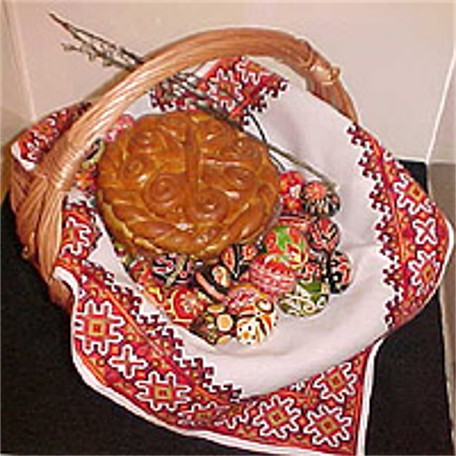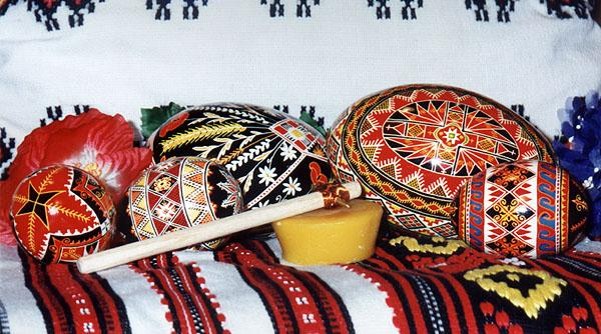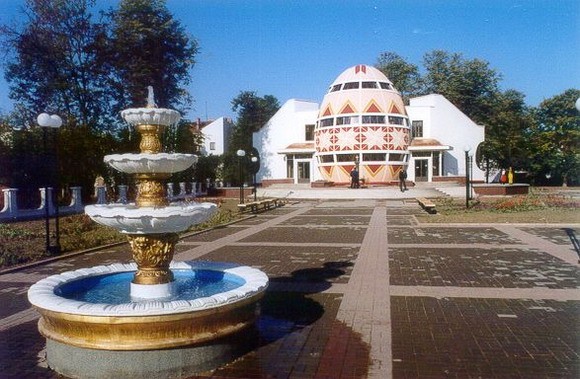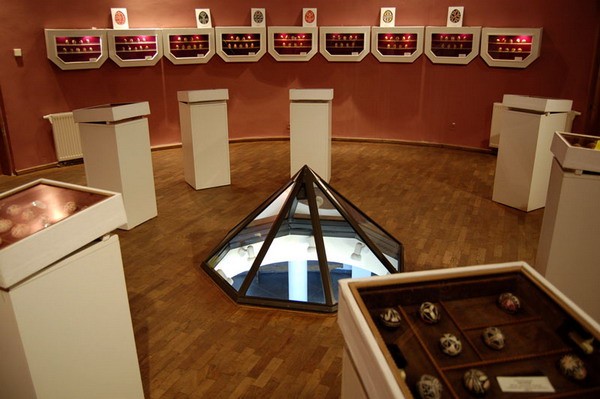Easter egg
Easter egg or pysanka. Pysanka painting is a widely practiced form of decorative art in Ukraine. The practice originated in the prehistoric Trypillia culture. Ukrainian pysanky have a symbolic significance. They symbolize spring, renewed life, and resurrection and have thus become associated with the celebration of Easter. Today pysanky are also appreciated as works of art.
Pysanky can be made of various materials—poultry (usually chicken) eggs, stone, wood, or clay—and can be decorated by various techniques—by painting with a brush (malovanka), by dyeing the egg a solid color (krashanka), by dripping hot wax on the egg before dyeing it (kapanka), or by scratching a design on a dyed egg (driapanka). The pysanka (literally, ‘written egg’) is produced by a complex technique. An initial design on the egg is done in beeswax, which is applied to the surface with a special instrument called a kystka (a small, metal, conic tube attached to a wooden handle). The egg is then dipped in yellow dye. Then those elements of the design that are to be yellow are covered with wax and the egg is dipped in a red dye (sometimes two shades of red are used). After the surfaces that are to be red are covered with wax, the egg is dipped in an intense, dark dye (violet or black). So that the color will adhere well, the egg is sometimes washed with vinegar or alum before being dyed. When the design is completed, the egg is heated to melt off the wax. The process of ‘writing’ pysanky is similar to batik printing. Traditionally, the dyes were prepared by skilled folk artists from the roots, skin, or bark of various plants and trees according to traditional recipes. These dyes were resistant to light and did not smear. Synthetic aniline dyes are widely used today. Pysanky are usually decorated just before Easter. The ornamentation of the pysanky consists of ancient motifs such as the solar motif (represented by the circle, rose, swastika, triskelion, and other forms). The design and the appearance, based on a limited number of contrasting colors, are connected with the technique, form, and purpose of the pysanka. Since it is spherical, the pysanka can be appreciated from many perspectives.
A great variety of ornamental patterns are found on pysanky. Because of the egg's fragility, no ancient examples of pysanky have survived. The oldest designs of Ukrainian ornamentation are known only because of the continuity of the ritualistic tradition of painting pysanky. By a system of lines the decorator divides the surface into a number of regularly shaped sections. The decorative elements, such as dots, lines, crosses, cones, and zoomorphic or anthropomorphic motifs, are painted within these sections or at their junctions in symmetrical or asymmetrical arrangement.
In the central regions of Ukraine vegetative motifs, stylized and geometrical (in the Kyiv region and Poltava region), the meander (bezkonechnyk), and the stylized rose, symbolizing the sun, have been dominant elements in pysanka designs. In the Chernihiv region more naturalistic, asymmetrical, floral patterns have been widely used. Geometric ornamentation has been more prevalent in the western regions. Certain regions, however, such as the foothills of the Carpathian Mountains, have had their own, distinct ornamental patterns. In the Sokal vicinity floral ornamentation has been used in a florid manner. The designs and colors of the Boiko region have been more restrained: darker colors have been used near Drohobych and strongly contrasting colors near Kalush.
The pysanky of the Hutsuls are distinguished by their intricate designs and fine execution. In most, complex geometric ornamentation has dominated. Their strong and rich colors, color range, and combinations and complexity correspond to the ornamentation of the Hutsul wood carvings, metal art objects, and embroidery. The Hutsul region merits the name ‘land of the artists.’ It is not surprising that pysanka painting was most developed there.
In earlier times people believed in the magical powers of the pysanka. It could protect one from evil, cure illnesses, and defend homes from lightning and fire. Such folk beliefs are mentioned in 12th-century documents.
As an art form the pysanka, like weaving, embroidery, pottery, and wood carving, constitutes a source of new masterpieces of the decorative folk arts. In recent times the art of the pysanka as a traditional folk art has been revived, mainly among Ukrainians abroad. Sometimes elements of abstract art are introduced into the new designs. Contests and exhibits of pysanky attract much attention and admiration.
BIBLIOGRAPHY
Sumtsov, N. ‘Pisanki,’ KS, 1891, nos 5–6
Kulzhinskii, S. Opisanie kolektsii narodnykh pisanok (Lubny 1899)
Klinger, W. Jajko w zabobonie ludowym (Cracow 1908)
Shcherbakivs’kyi, V. Osnovni elementy ornamentatsiï ukraïns’kykh pysanok ta ïkhnie pokhodzhennia (Prague 1925)
Taranushenko, S. Ukraïns’ki pysanky iak pam'iatky narodn’oho maliarstva (Kharkiv 1928)
Hurhula, I. Pysanky Skhidn’oï Halychyny i Bukovyny v zbirtsi Natsional’noho muzeiu u L’vovi (Lviv 1929)
Skoryk, M. ‘Boikivs’ki pysanky,’ Litopys Boikivshchyna, IV (Sambir 1934)
Surmach, G. ‘Easter Eggs,’ in Ukrainian Arts (New York 1952)
Biniashevs’kyi, E. Ukraïns’ki pysanky (Kyiv 1968)
Kalenychenko, L. ‘Mystetstvo pysanky,’ Narodna tvorchist’ ta etnohrafiia, 1971, no. 4
Markovych, P. Ukraïns’ki pysanky Skhidn’oï Slovachchyny (Prešov 1972)
Shcherbakivs’kyi, V. Ornamentatsiia ukraïns’koï khaty (Rome 1980)
Volodymyr Hodys
[This article originally appeared in the Encyclopedia of Ukraine, vol. 1 (1984).]
.jpg)
.jpg)
.jpg)
.jpg)
.jpg)
.jpg)




